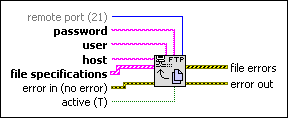FTP Get Multiple Files VI
Owning Palette: FTP VIs
Requires: Base Development System
Connects to an FTP server and copies a list of files to the local machine.

 Add to the block diagram Add to the block diagram |
 Find on the palette Find on the palette |
Owning Palette: FTP VIs
Requires: Base Development System
Connects to an FTP server and copies a list of files to the local machine.

 Add to the block diagram Add to the block diagram |
 Find on the palette Find on the palette |
 |
remote port is the TCP/IP port at which the server listens. The default is 21, the FTP control port. | ||||||
 |
password is the password that authenticates the username. (NI Linux Real-Time) You must specify a blank password. For NI Linux Real-Time targets, the FTP server does not accept NI-Auth credentials. | ||||||
 |
user is the name you want to use to log on to the FTP server. The default is anonymous. (NI Linux Real-Time) You must specify anonymous as the value for this input. For NI Linux Real-Time targets, the FTP server does not accept NI-Auth credentials. | ||||||
 |
host is the name or IP address of an FTP server. | ||||||
 |
file specifications contains the FTP configuration for file transfers.
| ||||||
 |
error in describes error conditions that occur before this node runs. This input provides standard error in functionality. | ||||||
 |
active specifies whether the data connection is active or passive. The default is TRUE, which specifies an active connection. | ||||||
 |
file errors is an array of error clusters containing file-related errors, such as invalid remote path and file access permission denied. | ||||||
 |
error out contains error information. This output provides standard error out functionality. |